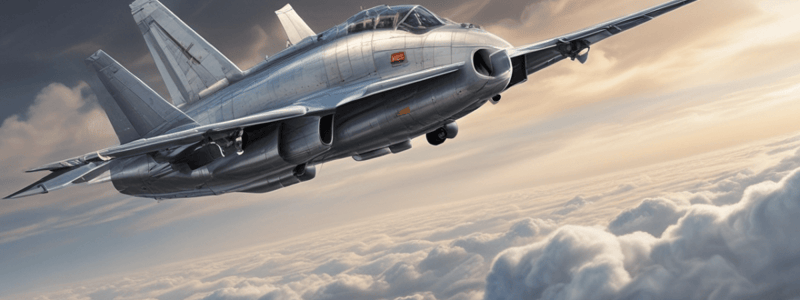Podcast
Questions and Answers
What is the primary reason pilots need to adjust their approach speed and landing roll during high-temperature landings?
What is the primary reason pilots need to adjust their approach speed and landing roll during high-temperature landings?
- To compensate for the increased air density
- To account for the reduced lift and drag
- To ensure adequate runway length for stopping (correct)
- To reduce the risk of engine failure
Why is it crucial for pilots to check temperature forecasts during pre-flight planning?
Why is it crucial for pilots to check temperature forecasts during pre-flight planning?
- To predict wind patterns and turbulence
- To determine the most efficient flight route
- To account for the impact of temperature on aircraft performance (correct)
- To adjust the aircraft's altitude and airspeed
What is the primary benefit of mastering the concepts of density altitude and ambient temperature?
What is the primary benefit of mastering the concepts of density altitude and ambient temperature?
- Increased climb rates
- Predicting aircraft behavior accurately (correct)
- Enhanced navigation skills
- Improved fuel efficiency
What should pilots refer to for precise calculations and performance data?
What should pilots refer to for precise calculations and performance data?
Why do performance charts include corrections for temperature variations?
Why do performance charts include corrections for temperature variations?
What is the primary consequence of failure to adjust for density altitude and ambient temperature?
What is the primary consequence of failure to adjust for density altitude and ambient temperature?
Why is it essential for pilots to be vigilant and proactive when operating in extreme temperature conditions?
Why is it essential for pilots to be vigilant and proactive when operating in extreme temperature conditions?
What is the primary purpose of applying temperature corrections during takeoff and landing?
What is the primary purpose of applying temperature corrections during takeoff and landing?
What is the primary factor that affects an aircraft's performance envelope?
What is the primary factor that affects an aircraft's performance envelope?
Why is it crucial for pilots to include temperature forecasts in their pre-flight planning?
Why is it crucial for pilots to include temperature forecasts in their pre-flight planning?
Higher temperatures always decrease the approach speed and landing roll during landing.
Higher temperatures always decrease the approach speed and landing roll during landing.
Pilots only need to check temperature forecasts during pre-flight planning for extreme weather conditions.
Pilots only need to check temperature forecasts during pre-flight planning for extreme weather conditions.
Mastery of density altitude and ambient temperature concepts only benefits experienced pilots.
Mastery of density altitude and ambient temperature concepts only benefits experienced pilots.
Aircraft performance charts do not account for temperature variations above a certain altitude.
Aircraft performance charts do not account for temperature variations above a certain altitude.
Pilots can safely ignore density altitude and ambient temperature considerations during emergency procedures.
Pilots can safely ignore density altitude and ambient temperature considerations during emergency procedures.
Ambient temperature has a greater impact on an aircraft's performance than density altitude.
Ambient temperature has a greater impact on an aircraft's performance than density altitude.
Pilots only need to adjust their flight plan for temperature forecasts during takeoff.
Pilots only need to adjust their flight plan for temperature forecasts during takeoff.
Temperature corrections are only necessary for aircraft with certain engine types.
Temperature corrections are only necessary for aircraft with certain engine types.
Pilots can estimate aircraft performance without consulting the Aircraft Flight Manual.
Pilots can estimate aircraft performance without consulting the Aircraft Flight Manual.
Density altitude and ambient temperature only affect aircraft performance at high altitudes.
Density altitude and ambient temperature only affect aircraft performance at high altitudes.
Explain how density altitude and ambient temperature impact an aircraft's approach speed and landing roll during landing.
Explain how density altitude and ambient temperature impact an aircraft's approach speed and landing roll during landing.
What is the purpose of performance charts in relation to temperature variations?
What is the purpose of performance charts in relation to temperature variations?
How do pilots ensure safe flight operations in extreme temperature conditions?
How do pilots ensure safe flight operations in extreme temperature conditions?
What is the significance of mastering the concepts of density altitude and ambient temperature for pilots?
What is the significance of mastering the concepts of density altitude and ambient temperature for pilots?
Why is it essential to consider both density altitude and ambient temperature when planning a flight?
Why is it essential to consider both density altitude and ambient temperature when planning a flight?
What is the role of the Aircraft Flight Manual in relation to density altitude and ambient temperature?
What is the role of the Aircraft Flight Manual in relation to density altitude and ambient temperature?
How do density altitude and ambient temperature impact an aircraft's overall performance?
How do density altitude and ambient temperature impact an aircraft's overall performance?
Why is pre-flight planning crucial for safe flight operations in extreme temperature conditions?
Why is pre-flight planning crucial for safe flight operations in extreme temperature conditions?
What is the relationship between density altitude and ambient temperature in aircraft performance?
What is the relationship between density altitude and ambient temperature in aircraft performance?
How do pilots ensure accuracy when applying temperature corrections during takeoff and landing?
How do pilots ensure accuracy when applying temperature corrections during takeoff and landing?
Flashcards are hidden until you start studying
Study Notes
Aircraft Performance Review
- Aircraft weight plays a pivotal role in its takeoff, climb, and overall efficiency.
- The relationship between aircraft weight and takeoff distance is direct; the heavier the load, the more runway needed.
- Aircraft weight also affects the rate of climb, which is critical in avoiding obstacles and attaining cruising altitude.
Airspeed Control
- Proper airspeed management ensures adequate lift and prevents stall, particularly in takeoff climb and approaching the runway for landing.
- Techniques for maintaining airspeed control include adjusting throttle and control surfaces in response to changing conditions, such as wind shear.
Integrating Weight and Airspeed Considerations
- Balancing aircraft weight and airspeed control is crucial for performance optimization.
- Commercial pilots must consider these factors to manage the aircraft's behavior throughout different phases of flight effectively.
Preparation Tips for Final Assessment
- Revisit video lectures and reading materials to reinforce understanding of aircraft performance factors.
- Reflect on real-world scenarios where performance factors come into play, and think about how to respond.
Flight Planning and Performance Scenarios
- Apply critical data from the Aircraft Flight Manual (AFM) to real-world scenarios.
- Learn to make informed pre-flight plans and in-flight adjustments essential in commercial aviation.
- Explore low-speed flight operations and the nuances of flying within the region of reversed command.
Density Altitude
- Density altitude is the altitude relative to standard atmosphere conditions at which the air density would be equal to the current air density.
- Calculating density altitude involves accounting for variations in temperature and pressure.
- The formula for density altitude calculation is: Density Altitude = Pressure Altitude + [120 x (OAT - ISA Temp)]
- Density altitude has a profound impact on aircraft performance, including:
- Reducing engine power output, propeller efficiency, and wing lift
- Increasing takeoff roll
- Hinder climb performance
Ambient Temperature
- Ambient temperature affects aircraft performance in several ways, including:
- Reducing engine efficiency and lift, leading to longer takeoff distances
- Affecting approach speed and landing roll during landing
- Requiring corrections for temperature variations in performance charts
Mastering Aircraft Performance
- Commercial pilots must balance weight and airspeed considerations to manage the aircraft's behavior throughout different phases of flight effectively.
- Performance optimization requires integrating weight considerations with airspeed control.
- Key factors affecting aircraft performance include weight, airspeed, weather, and runway environment.
Takeoff and Landing Considerations
- Takeoff and landing operations are critical phases of flight where performance planning and aircraft control are crucial.
- Factors affecting takeoff and landing performance include air density, runway condition, and aircraft weight.
- In-flight adjustments are necessary to adapt to changing weather conditions, such as temperature changes and icing conditions.
Flight Planning and Performance Scenarios
- Flight planning involves applying critical data from the Aircraft Flight Manual (AFM) to real-world scenarios.
- In-flight adjustments are necessary to respond to changing conditions, such as altitude changes, fuel burn, and ETA.
- Low-speed flight operations require techniques for aircraft control in the region of reversed command.
- Effective performance planning integrates data with dynamic factors such as weather variations and ATC communications.
Density Altitude and Ambient Temperature
- Density altitude is a crucial concept that directly influences the performance of an aircraft.
- Density altitude is the altitude relative to the standard atmosphere conditions at which the air density would be equal to the current air density.
- Calculating density altitude involves accounting for variations in temperature and pressure using the formula: Density Altitude = Pressure Altitude + [120 x (OAT - ISA Temp)].
- Higher density altitudes indicate less dense air, reducing engine power output, propeller efficiency, and lift generated by the wings.
- Ambient temperature affects aircraft performance, including:
- Longer takeoff distances due to reduced engine efficiency and decreased lift.
- Direct effects on the aircraft's systems and aerodynamics.
- Corrections for temperature variations in performance charts.
- Mastery of density altitude and ambient temperature concepts allows pilots to predict aircraft behavior accurately, make informed decisions, and conduct flight operations safely and efficiently.
Mastering Aircraft Performance
- Commercial pilots must balance weight and airspeed considerations to manage the aircraft's behavior throughout different phases of flight effectively.
- Performance optimization requires integrating weight considerations with airspeed control.
- Key factors affecting aircraft performance include weight, airspeed, weather, and runway environment.
Takeoff and Landing Considerations
- Takeoff and landing operations are critical phases of flight where performance planning and aircraft control are crucial.
- Factors affecting takeoff and landing performance include air density, runway condition, and aircraft weight.
- In-flight adjustments are necessary to adapt to changing weather conditions, such as temperature changes and icing conditions.
Flight Planning and Performance Scenarios
- Flight planning involves applying critical data from the Aircraft Flight Manual (AFM) to real-world scenarios.
- In-flight adjustments are necessary to respond to changing conditions, such as altitude changes, fuel burn, and ETA.
- Low-speed flight operations require techniques for aircraft control in the region of reversed command.
- Effective performance planning integrates data with dynamic factors such as weather variations and ATC communications.
Density Altitude and Ambient Temperature
- Density altitude is a crucial concept that directly influences the performance of an aircraft.
- Density altitude is the altitude relative to the standard atmosphere conditions at which the air density would be equal to the current air density.
- Calculating density altitude involves accounting for variations in temperature and pressure using the formula: Density Altitude = Pressure Altitude + [120 x (OAT - ISA Temp)].
- Higher density altitudes indicate less dense air, reducing engine power output, propeller efficiency, and lift generated by the wings.
- Ambient temperature affects aircraft performance, including:
- Longer takeoff distances due to reduced engine efficiency and decreased lift.
- Direct effects on the aircraft's systems and aerodynamics.
- Corrections for temperature variations in performance charts.
- Mastery of density altitude and ambient temperature concepts allows pilots to predict aircraft behavior accurately, make informed decisions, and conduct flight operations safely and efficiently.
Studying That Suits You
Use AI to generate personalized quizzes and flashcards to suit your learning preferences.




